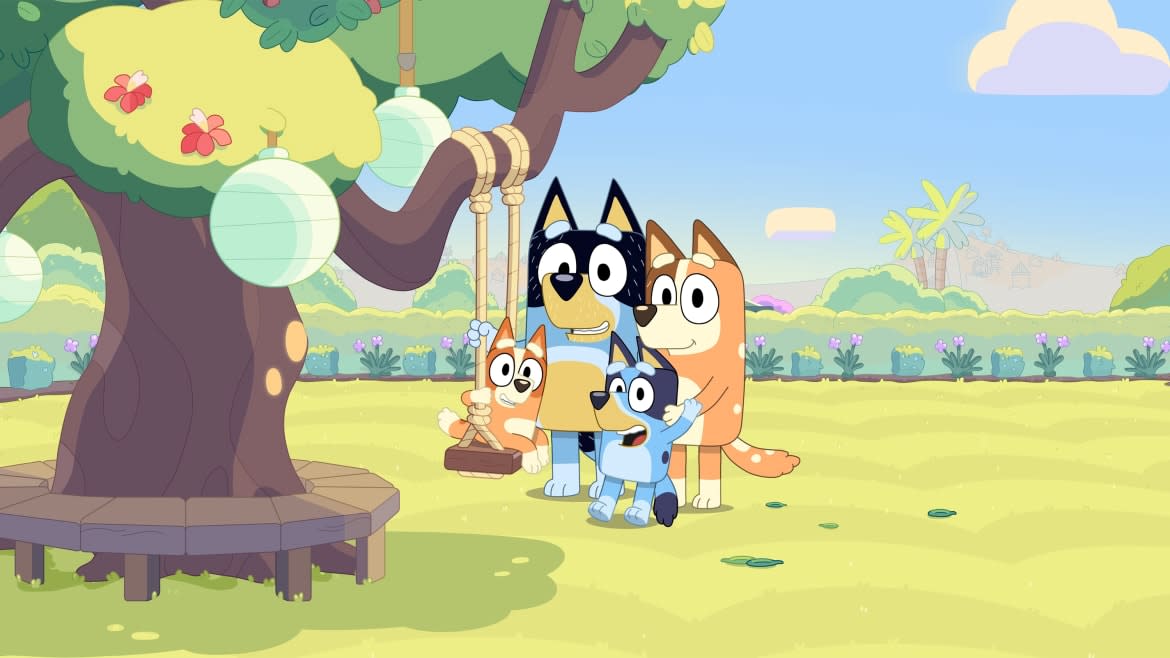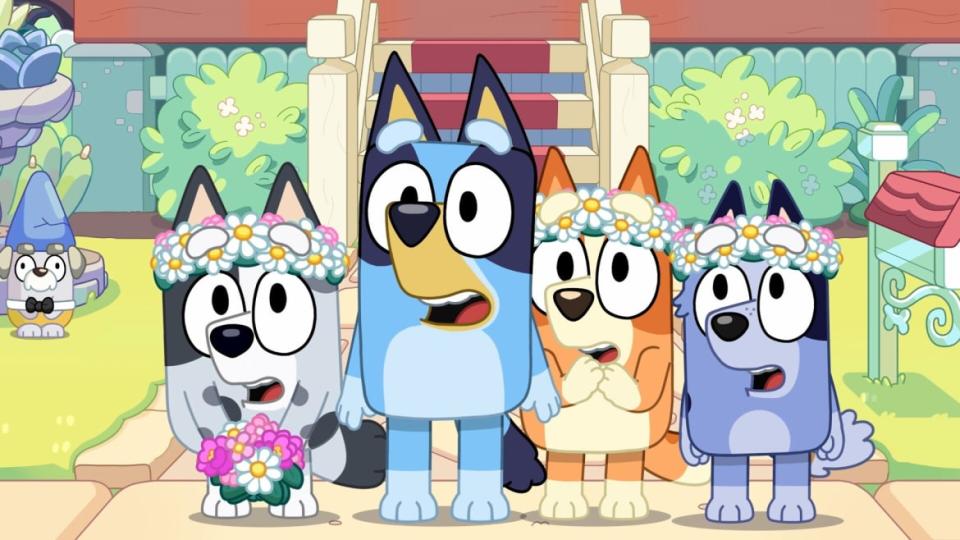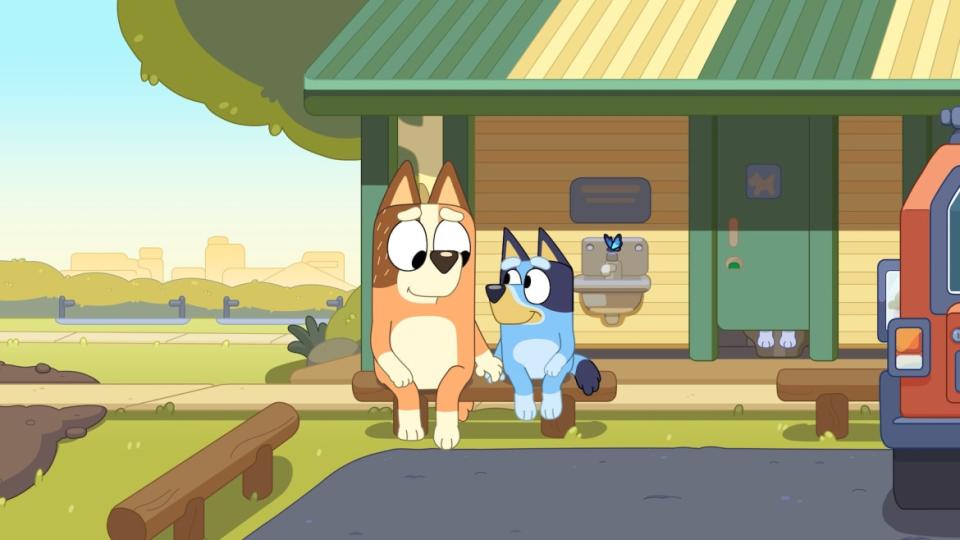The Week the World Wept Over Kids Show ‘Bluey’

There was a wackadoo of an international incident this week.
It was an event so shattering that adults around the globe were immediately reduced to tears. There is no known cure for the weeping that occurs surrounding this inciting party: a family of cartoon Australian dogs who might be moving out of their house.
The animated series Bluey, which streams on Disney+ in the U.S., is a phenomenon. But this week—in which the sheer number of grown adults allegedly crying along to its season finale has made headlines across the globe—the show reached a whole new level of relevance. And, now that I’ve seen the episode myself (and sobbed silently alone while watching) I have some thoughts as to why this show has become such a big deal—and a crucial, necessary part of pop culture.
The series first launched in 2018, about a 6-year-old Australian cattle dog named Bluey, her sister Bingo, and her parents Chilli and Bandit. The inherent whimsy of Bluey and Bandit’s wanderlust elicits giggle fits from children enamored by the characters’ rambunctious zeal for playtime. On the other hand, the breezy, yet meticulous capture of how parents relate to their kids on a daily basis, in all its big and small moments, has proven borderline jarring for adults. Understandably, most are unprepared to confront such pointed, accurate feelings in a cartoon meant to occupy their kids for a few minutes while they make dinner. The series crystallizes the experience of something that seems so amorphous and complicated: being a family.

Bluey
The “adults enjoy it as much as the kids” genre of children’s programming is certainly nothing new; Pixar has built a billion-dollar reputation around that very thing. But there’s something about Bluey that hits differently, especially gauging by the surge in Kleenex stock since the series premiered. (Editor’s note: I made that fact up.)
At a time when everything about juggling life’s responsibilities—especially, I’d imagine, raising children—seems just so impossibly hard, Bluey’s ultra-simple storylines (being caught in the rain with your daughter; taking the kids along to pick up takeout) fly like a dart through a storm cloud of life’s complicated stuff, landing a bullseye right at the heartstrings. Like any bullseye, that it accomplishes such a thing catches you by surprise and feels like a miracle.
Most adults who have seen Bluey will tell you that its jokes are funnier than the lion’s share of comedies on TV, while its ability to juggle that with such pure, authentic feeling is almost singular. It’s not a huge surprise that the series ranks among the most streamed programs in the entire world.
Naturally, then, when there’s a very special episode of Bluey, it’s going to be a big deal. The hysteria surrounding “The Sign,” the supersized episode that was released this week and which has generated its own news cycle of headlines, may be the biggest episode of Bluey yet. And, as this is Bluey, that means everyone is crying.
I do not have children. I do, however, have nephews that I posted so many photos of on Instagram that several people thought I did, indeed, have children—which, I understand, is basically the same as raising them myself. As such, I have long been immersed in the Bluey-verse, fearful that the worst thing imaginable would happen if it wasn’t: a set of 5-year-old twins would think I was not cool.
The coverage surrounding “The Sign” this past week has elevated the episode to Event Status. But because Bluey is a children’s show, the kind of program that most media outlets aren’t used to putting a spotlight on this genre. As such, the reporting was that of befuddlement: “Bluey: ‘The Sign’ Episode Had Adults Crying. Is that Weird?” “The Bluey Season Finale Is Here and Grownups Are Not OK.” And the breathless explainer report: “Parents Are Sobbing Over Bluey. Is the Show Ending? What We Know.”
I viewed the episode in a manner I imagine most parents around the world watched: in a hotel bathtub at 11 p.m. while sipping on minibar wine. But the circumstances in which one screens “The Sign” are not important. The result is all that matters: Oh boy, did I cry.
The episode’s running time alone telegraphed that this was going to be a monumental episode of Bluey. Most installments of the series are about seven minutes long, as perfect for “one more episode before bed time” negotiations as they are at holding preschoolers' attention. “The Sign,” however, clocks in at over 30 minutes, more than four times the length of a regular episode.
How ‘Bluey’ (Really, Truly) Changed Parenting—And the World
From the jump, it’s clear that the outing was going to swing wrecking balls at your tear ducts, as if your fragile emotional state was an existential construction site. “Why do stories always have happy endings?” Bluey asks her teacher at school. “Well, I guess because life will give us enough sad ones,” she replies. Jesus.
Chilli and Bandit are hosting the wedding of Bandit’s brother, Radley, to one of Chilli’s friend, Frisky, in their backyard. It will likely be the last big gathering at the house: Wanting to think bigger for his family, Bandit takes a job in another city, meaning that Bluey, Bingo, and Chilli have to come to terms with leaving their beloved home.
Bluey is so distraught over this that she tries to extract the For Sale sign from the front yard. It becomes clear, through subtle hints, that Chilli is also having a hard time with the move. But their anxieties are soon distracted when Frisky runs away on the wedding day, after facing a similar crisis: She learns that Radley plans for them to move away from town too once they’re married.
Much of the episode plays out as TV’s most adorable chase scene, with Chilli loading Bluey, Bingo, and their cousins in the car and setting off to find Frisky and convince her to come back to get married. Each unplanned stop and twist on the way excavates new feelings from both Bluey and Chilli about the impending move, creating a marvel of dual empathy: You understand the massive, hard-to-reason-with feelings Bluey is having as a child facing having to say goodbye to her friends and her home, and the more complex, mature emotions that Chilli is dealing with.
She is torn between her own misgivings about leaving and knowing this could be the best thing for the family, but must bury that internal debate in order to be a strong example for Bluey. It’s one of those fleeting gut-punches that Bluey does so well, illuminating the ways in which parents do and say things to help their kids be brave—even if they could use help being brave themselves.
‘Abigail’ Somehow Squanders a Murderous Vampire Child in a Tutu
One of the more cynical takes about Bluey is that the series caters to parents, or even serves as therapy for them, more than it is a show for kids. I hate that argument. First of all, I’ve seen the pandemonium at Bluey events first hand; the youths are obsessed. I also think the sophisticated emotional truths that dance along with the goofiness of these gregarious characters are absorbed by kids. They may not have the language to break down why certain moments in the show are so poignant, but I believe that the notion that something meaningful is happening between parents, between siblings, and between family contributes to their fascination with this show.
There’s a moment when Chilli and Bandit join hands. Bandit asks, “Am I making a mistake?” Chilli, after a full episode of questioning the move, responds, “Probably. But let’s make it together.” (I yelped a little bit and my heart took an express elevator to my throat as I typed that.)
Frisky and Rad’s wedding happens, which means I can now count *Bluey* among the weddings I’ve cried at on TV, for the love of God. And then Bluey goes for nuclear emotional devastation.

Bluey
The final two and a half minutes play out wordlessly, as the family summons the fortitude and courage to say goodbye to their home, simultaneously mourning and cherishing the memories they made as a family there. It is the 2024 version of the Up opening scene, and just as gorgeous—and ravaging. Because this episode has been so huge and there’s been so much coverage of it, you can easily find out what happens during that sequence—but I won’t spoil it for you.
It’s interesting to engage with Bluey doing something so…big. A big episode. A big life change. It even seemed to intentionally court this big reaction. But I think it’s earned.
So much of the show’s emotional power comes in its brevity. Episodes are a slice of life: seven minutes about a trip to the store, bedtime, building a playset in the backyard... They’re fleeting, everyday, even mundane activities, but they vibrate with every extreme of meaning, often in rapid, contradictory succession—just like in real life. The simplest and the hardest thing to do is get through a day. Bluey, somehow, captures that. It’s a show that understands that the sheer amount of love you feel makes each day’s many tasks run the full gamut of tedious to rewarding, insurmountable to profound, and every note of joyous, shattering, exhausting, invigorating, and beautiful that falls in between.
We’re so preoccupied by so many things right now, be it the news, the endless pop culture options, or the demands of our lives. I think this episode is resounding in the way it is because it grounds us. In these two-dimensional Australian dogs, we get a very human reminder that we’re not receiving anywhere else. Validate all the moments, good or bad, big or small; feel each feeling without apologies; be strong; and give the love and ask for the love you need to get through all of it.
Get the Daily Beast's biggest scoops and scandals delivered right to your inbox. Sign up now.
Stay informed and gain unlimited access to the Daily Beast's unmatched reporting. Subscribe now.


